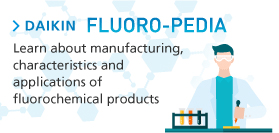Daikin's approach to PFOA
Updated : May 13, 2024
This page provides an overview of perfluorooctanoic acid (PFOA), one of the perfluoroalkyl and polyfluoroalkyl substances (PFAS), and Daikin Industries’ relevant initiatives in Japan.
As a company that manufactured and used of PFOA in the past, we will continue to monitor trends relevant to PFOA and take action in consultation with the Japanese government and local authorities. Daikin will also provide more information on PFOA and the status of the company’s initiatives via its website to the local communities and other stakeholders.
- About PFOA
- Moves to regulate PFOA
- Current water environment in Settsu City, Osaka Prefecture, Japan
- Health effects
- Pumping and cleanup of groundwater in Settsu City
- Installation of impermeable walls
- Briefing to local and surrounding residents
- Daikin’s attitude
1) Daikin’s involvement with PFOA
About PFOA
Perfluorooctanoic acid (PFOA) is one of the perfluoroalkyl and polyfluoroalkyl substances (PFAS), a generic term for a diverse group of over 10,000 organofluorine compounds.
PFOA had been used in a variety of applications in a wide range of industries, not limited to chemical industries. In addition to its use as a surface-active agent and the production aide for fluoropolymers, chemical products manufactured using PFOA had been used as water, oil and grease repellents and/or dirt repellents in everyday products (e.g., fibers, electronic substrates, automobiles, food wrapping paper, stone materials, flooring, leather, and protective clothing).
In the early 2000s, the presence of PFOA in wildlife, humans, and the environment was reported, and gradually its long-term persistence in the environment was recognized.
Moves to regulate PFOA in Japan
In 2014, the Ministry of the Environment of Japan designated PFOA along with perfluorooctanesulfonic acid (PFOS), another type of PFAS, as “Investigated Items” to accumulate knowledge of the two substances. The “Investigated Items” are defined as substances that have the potential to cause harmful effects on human health and ecosystems via the water environment (hereinafter referred to as environmental risks) but have relatively small risks, or substances that have unknown environmental risks but require the accumulation of knowledge on environmental risks from the perspective of detecting them in the environment.
Subsequently, in 2019, PFOA was designated as a restricted substance under the Stockholm Convention on Persistent Organic Pollutants. In October 2021, the manufacture, import, and use of PFOA in Japan were prohibited in principle under the Act on the Evaluation of Chemical Substances and Regulation of Their Manufacture, etc. Under the Act on the Evaluation of Chemical Substances and Regulation of Their Manufacture, etc., the manufacture, import, and use of PFOS and PFHxS, other types of PFAS, are prohibited. Daikin, including all of its affiliates, has no history of manufacturing, importing, or using PFOS and PFHxS.
In 2006, Daikin’s affiliate joined the PFOA 2010/2015 Stewardship Program (a voluntary PFOA reduction program) with seven other major global fluorochemical companies, aiming to eliminate PFOA and related substances by 2015. Daikin discontinued manufacturing and using PFOA at the Yodogawa Plant in Settsu City, Osaka Prefecture, Japan by 2012, and across the Daikin group, including overseas, by 2015.
In May 2020, the Ministry of the Environment of Japan designated PFOA and PFOS as “Monitored substances”. These substances are not immediately considered as EQSs under the Water Pollution Prevention Act, based on the current detection level in public waters and groundwater, but are identified as needing further observation. A total of 50 ng/L or less for PFOS and PFOA has been established as a provisional guideline value (hereinafter referred to as the Guideline Value (provisional)) for rivers and drinking water. The Guideline Value refers to the concentration level in the water environment established by the Ministry of the Environment of Japan with due consideration for safety based on the level at which continuous exposure over a lifetime does not cause any adverse health effects while considering the exposures from other sources. Since its assessment has not yet been established globally, at present, it is difficult to establish a specific reference or guideline value for PFOA based on the toxicological point of view. Nevertheless, considering the significance of providing a reference value from the perspective of enhanced monitoring, the Ministry of the Environment of Japan has designated the value deemed appropriate in reference to the assessments performed in various countries and organizations. For this reason, the value is considered provisional.
No guideline values are specified for soil and food (e.g., rice and vegetables) in Japan.
In February 2023, PFOA and PFOS were specified as “Designated substances” under the Water Pollution Prevention Act in Japan. The “Designated substances” are those specified by Cabinet Order of Japan as substances which are suspected to be harmful to public health or to cause damage that is likely to negatively affect living conditions by being discharged into Areas of Public Waters in large quantities. PFOA was specified as a "Designated substance” thereunder because it is included in the list of “Monitored substances.” In accordance with this designation, in case of there is a risk of damage to human health or the living environment due to water containing PFOA being discharged into public waters or seeping underground as a result of damage or other accidents to factories that manufacture or treat PFOA, the establisher of the factory is required to take emergency measures to prevent the discharge or seepage of water containing PFOA and to notify the prefectural governor of the accident and a summary of the measures taken.
Daikin has been operating its business while monitoring regulatory trends represented by the above and will continue to monitor them closely.
Reference (in Japanese only) :
Current water environment in Settsu City, Osaka Prefecture, Japan
According to a release by the Ministry of the Environment of Japan, a nationwide water quality survey has detected PFOA values exceeding the guideline value (provisional) in some groundwater and rivers in Japan. According to the information on the Settsu City website, as of May 7, 2024, the PFOA values of the city’s tap water are confirmed to be below the guideline value (provisional). On the other hand, according to a release from Osaka Prefecture, PFOA values exceeding the guideline value (provisional) were detected in the groundwater of Settsu City in a survey conducted in August 2022 by Osaka Prefecture.
Recognizing that Daikin’s products are one of the causes of the groundwater situation in Settsu City, Daikin has consulted with Osaka Prefecture and Settsu City and taken measures, such as groundwater pumping and purification, since 2009.In order to reduce PFOA concentrations in the future, Daikin believes it should continue to take measures such as pumping and purification of groundwater, in addition to the impermeable walls described below.
Health effects
No internationally uniform conclusion has yet been reached regarding the health effects of PFOA and there is considerable variation in the assessment of PFOA by countries and organizations. In December 2023, the International Agency for Research on Cancer (IARC), the cancer agency of the World Health Organization (WHO), evaluated the strength of evidence for carcinogenicity and classified PFOA into Group 1. As explained by the Food Safety Commission of Japan, the IARC evaluation does not indicate the actual probability or severity of carcinogenesis in humans. Daikin will continue to monitor trends in PFOA by collecting information on the latest assessments of PFOA by countries and agencies.
2) Initiatives by Daikin so far

Late 1960s to 1990s
Daikin began handling PFOA purchased from other companies in Japan in the late 1960s and later began producing PFOA in-house and using PFOA together with products purchased from other companies in the 1980s. It was used not only as water and oil repellents but also as the production aide for fluoropolymers. From the late 1960s until the 1990s, there were no legal restrictions, including on emissions and drainage.
Around 2000
Recognizing the potential for the long-term persistence of PFOA in the environment, Daikin voluntarily initiated efforts to reduce environmental emissions during the manufacture and use of PFOA and started the development of alternative substances as part of its chemical management.
2006
Eight major global fluorochemical companies, including Daikin’s affiliate, joined the PFOA 2010/2015 Stewardship Program (a voluntary PFOA reduction program) launched by US EPA, aiming to eliminate PFOA and related substances by 2015.
2009
As a measure against PFOA in groundwater at the Yodogawa Plant site in Japan, Daikin started a voluntary and continuous purification efforts while exchanging information with Osaka Prefecture and Settsu City.
2011
Daikin discontinued the use of PFOA at the site in U.S.
2012
Daikin discontinued the production and use of PFOA at the sites in Japan.
2015
Daikin discontinued the production and use of PFOA and related substances at overseas sites.
Accordingly, the production and use of PFOA and related substances were discontinued at all sites globally.
2020
Taking the guideline value (provisional) of 50 ng/L or less in Japan as its voluntary environmental target, Dakin has decided to strengthen its efforts for purification and preventing outflow and began groundwater surveys while receiving expert advice.
2022
Based on the groundwater survey results conducted since 2020 and expert advice, Daikin decided to install impermeable walls at the site boundaries in Settsu City and enhance purification systems as permanent purification and outflow-prevention measures and began conducting detailed surveys necessary for system installation and enhancement.
3) Planned action at Daikin
Pumping and Purification of groundwater in Settsu City
The Yodogawa Plant has installed wells to pump up groundwater, which is then purified using on-site purification system with filtration, adsorption, and finish adsorption functions, and the adsorbents used for purification are properly treated.
This purification effort began in 2009 after discussing countermeasures with Osaka Prefecture and Settsu City, with a planned initial pumping capacity of 30,000 tons annually. Since the start of the purification activity, Daikin has gradually increased pumping capacity while verifying that there is no effect of land subsidence. Currently, the Yodogawa Plant pumps and purifies 60,000 tons of groundwater annually.
Since 2020, upon advice from experts, Daikin has been making improvements to ensure more efficient treatment by analyzing the underground water vein flow and adjusting the location of additional wells.
Yodogawa Plant sends purified groundwater, along with other plant effluents, to the Central Water Mirai Center (Sewage Treatment Plant) of the Osaka Prefecture Northern Regional Sewerage Works Office. Daikin has received a request from Osaka Prefecture that the effluent from the plant should have a concentration of 10 times the guideline value (provisional) of 50 ng/L as a reference. Therefore, the company regularly monitors the PFOA concentrations in factory effluent containing purified groundwater, in addition to the items restricted by the Water Pollution Prevention Act.
Installation of impermeable walls
Upon advice from experts, Daikin plans to install impermeable walls that will enclose the perimeter of the Yodogawa Plant site in Settsu City. The impermeable walls intend to contain PFOA that remains on the site within the site.
Together with experts, we verified the impermeable walls’ functionality, the impact of noise and vibration on the surrounding area during construction, and issues to be addressed during full-scale construction work, using the pilot impermeable walls, in June 2023.
Based on the verification results with the pilot impermeable walls, Daikin started the official installation of the impermeable walls in November 2023.

Installation of pilot impermeable walls
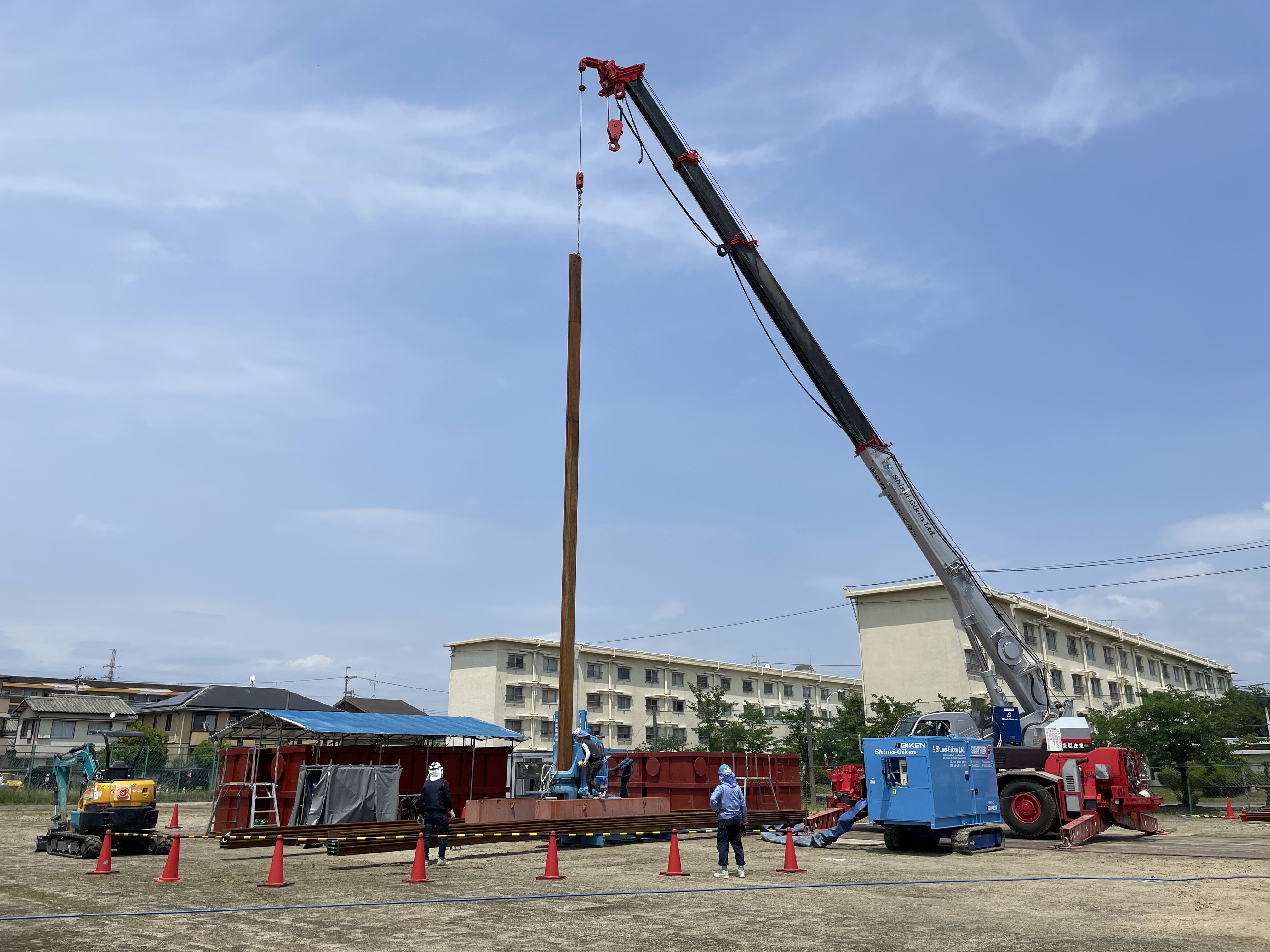
Installation of pilot impermeable walls
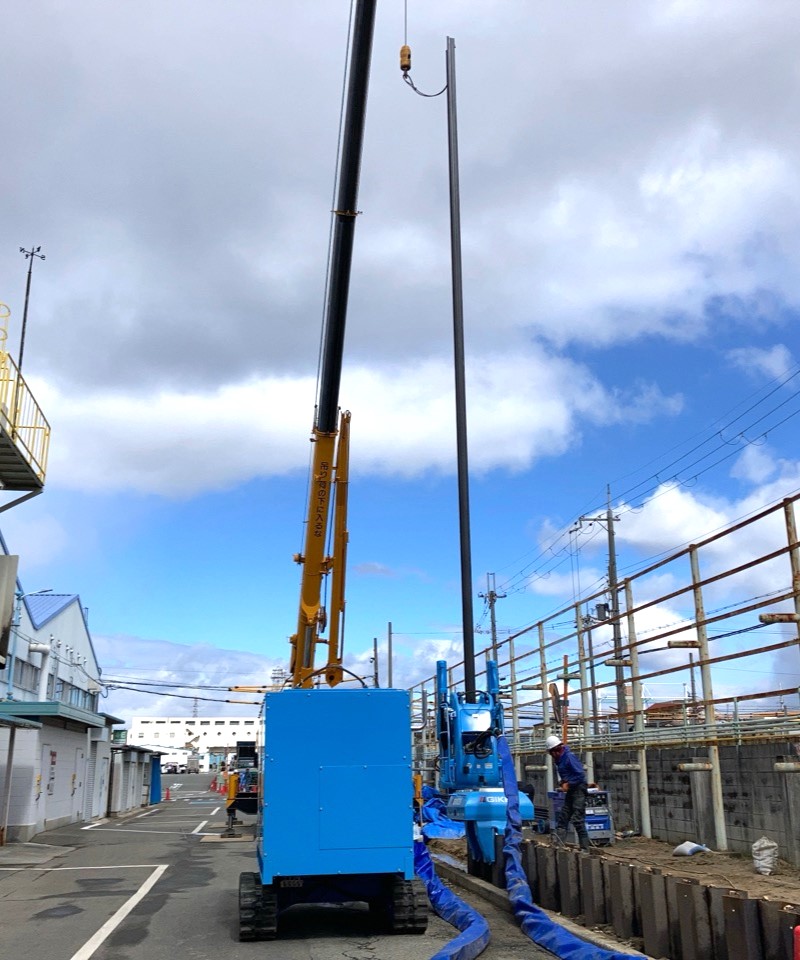
Installation of impermeable walls
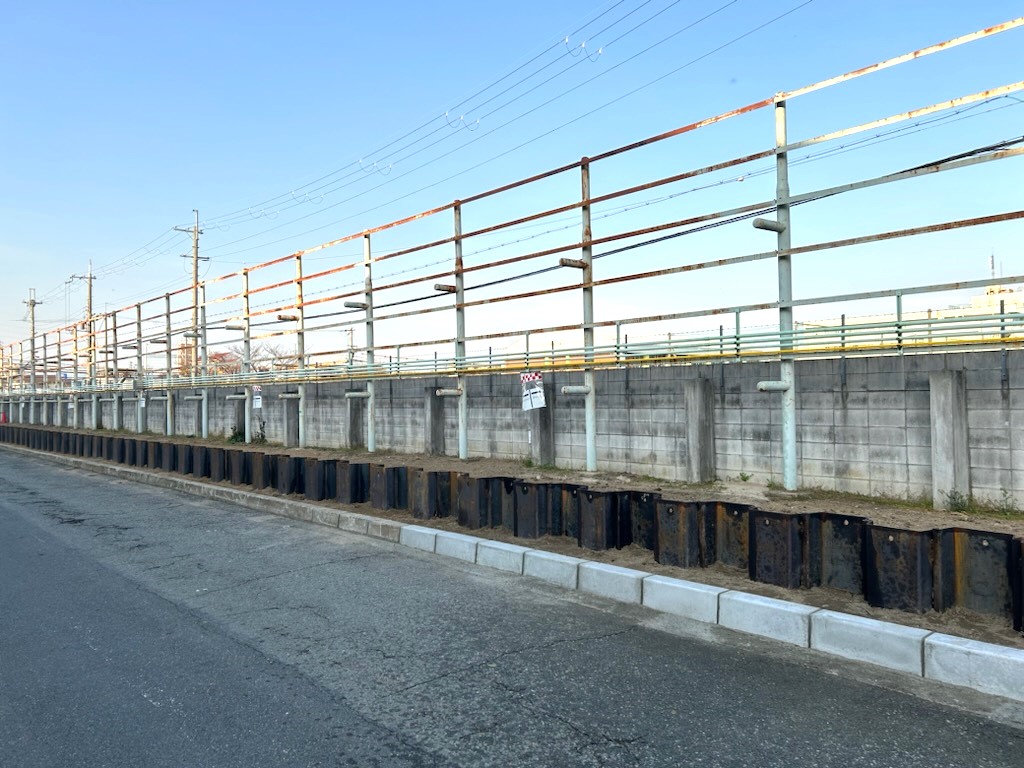
Impermeable walls
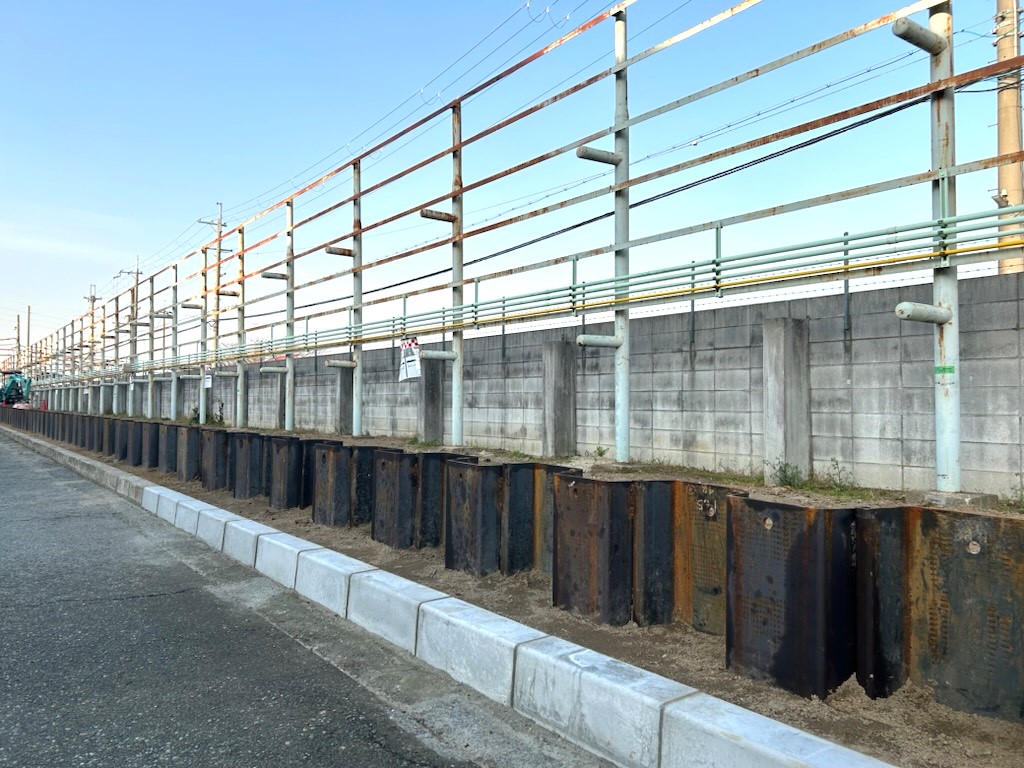
Impermeable walls
Briefing to local and surrounding residents
Daikin has been creating opportunities to explain the properties of PFOA and the company’s initiatives, including plans to pump groundwater and install impermeable walls, to residents’ associations near the Yodogawa Plant in Settsu City.
In June 2023, in response to a request from the Settsu City Standing Committee on Civil Affairs, Daikin held a briefing session and a tour of the effluent treatment facility for committee members.
Daikin will continue to create opportunities for dialogue with local and surrounding residents as appropriate.
Daikin’s attitude
As a company that manufactured and used PFOA in the past, Daikin will continue monitoring trends relevant to PFOA and take action in consultation with the Japanese government and local authorities.
